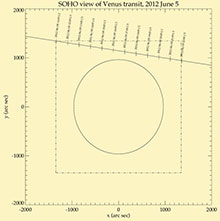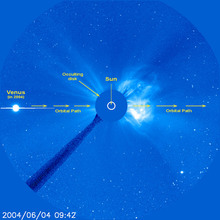Transit of Venus 2012 for SOHO
(dedicated to the memory of Jean-Baptiste Chappe d'Autoroche*)
Movies and images from SOHO's Pick of the Week (Transit and
Path) and
SDO's Venus
Transit site.
On June 5, 2012 at sunset on the East Coast of North America and earlier for other parts of the U.S., the planet Venus will make its final trek across the face of the Sun as seen from Earth until the year 2117. The last time this event occurred was on June 8, 2004 when it was watched by millions of people across the world. The entire transit will take about six hours if one is able to view the entire event.
There will be many ways to watch the transit. Hundreds of astronomy clubs, observatories, museums, universities and others are offering opportunities to view the event though solar telescopes. The Solar Dynamics Observatory will be presenting near real-time views of its from their spacecraft on the SDO site (http://sdo.gsfc.nasa.gov). SOHO will also observe Venus pass by the Sun but, due to SOHO.s position, Venus will not cross directly in front of the Sun from the viewpoint of its solar imagers. Because SOHO's halo orbit about the L1 Lagrange point takes it as much as 120,000 km out of the ecliptic plane, and Venus will only be about 41 million km from the earth at the time of the transit, SOHO's different viewpoint produces just enough of an angular difference to move Venus's apparent track off the disk of the Sun --- as seen from SOHO. The graphic below shows how Venus will appear in the coronal area of the sun for SOHO's EIT imagers.

Only SOHO, however, has one thing that no one else can provide: views of the march of Venus as it approaches the Sun days, before the actual transit, and then moves away from the Sun for several days after the transit. Venus should first enter the LASCO C3 field of view early on June 1. should thenen be occulted between early June 4 and very late June 7, finally exiting C3 late on June 11. As Venus gets closer to the Sun, it should enter the narrower, LASCO C2 field of view somewhere near the middle of June 3, disappear behind occulting disk between early June 5 and reappear early June 7, and leave C2's view of it middle or late on June 8.
You can monitor its passage on our site viewing the latest LASCO C3 and C2 movies and our Venus Heading for Transit story.
This is an illustration of the path of Venus will take. This SOHO C3 coronagraph image is from the transit of 2004, but shows a similar path for Venus for 2012:

And this is an illustration from Fred Espenak that shows where people around the world can see the transit: here.
For over 100 years the main quest of astronomers was to pin down the distance between Earth and Sun (called the Astronomical Unit), which would give them a key to the size of the solar system. Careful studies of the transit of Venus became the gold mine they would harvest to reveal this measure.
You can review SOHO's coverage of the 2004 transit here: http://sohowww.nascom.nasa.gov/hotshots/2004_06_08/
You can find a wealth of additional information and resources about the transit on many websites, including NASA's sunearthday.nasa.gov site and transitofvenus.org.
* In the days of heroic astronomy, Chappe d'Autoroches not only risked his life twice to obtain critical, new knowledge from transits of Venus, but gave his life to help others in dire need. Here is his tale from the h2g2 web site in an article entitled "Forgotten Male Astronomers:" A French expedition led by Jean-Baptiste Chappe d'Autoroche (1728 - 69) went to Tobolsk, Siberia, to record the 1761 Venus transit. The team survived a treacherous river crossing and a lengthy journey through difficult, boggy conditions, eventually arriving at their destination just six days before the transit was due. Just before the transit, Jean-Baptiste was attacked by some of the locals, who believed he had caused unusually severe spring floods by interfering with the Sun. Cossack guards managed to save the team of astronomers, who eventually managed to make good observations of the Venus transit.
The French Academy were so pleased with the success of his mission that they engaged Jean-Baptiste to record the next expected Venus transit, due in 1769. He specified that he would travel anywhere in the world as long as the temperature wouldn't be below freezing. Tragically, when Jean-Baptiste and his team arrived at Vera Cruz in Mexico, they found themselves in the middle of a plague [yellow fever] epidemic. Instead of moving on to a safer place, the team decided to remain and help care for the sick villagers.
Even though he was mortally ill, Jean-Baptiste managed to record astronomical observations to establish the latitude and longitude of the site. These recordings were vital for the calculations of the astronomers back home in France, and were made with an astonishing accuracy, given the hazardous conditions in which the data were gathered. The observations they made provided some of the best data of the 1769 transit. Jean-Baptiste died of a fever just after the transit, aged 41 years.
A longer and more detailed version of these events can be found here: www.americanscientist.org.


